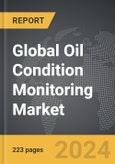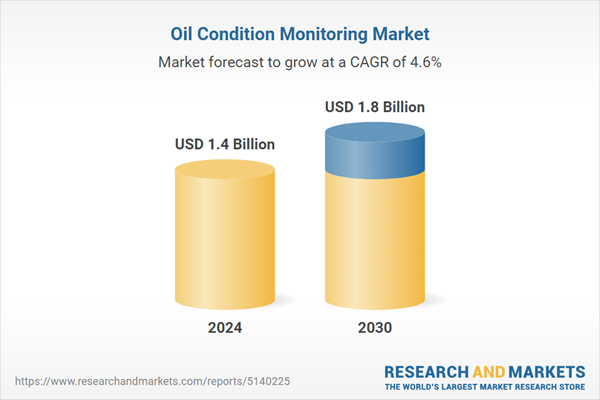Global Oil Condition Monitoring Market - Key Trends & Drivers Summarized
What is Oil Condition Monitoring, and Why is It Critical?
Oil condition monitoring (OCM) refers to the systematic analysis of lubricant properties and contaminants to assess the health of oil and machinery. It is widely used in industries like oil and gas, automotive, power generation, and manufacturing to monitor the condition of lubricants in critical equipment such as engines, turbines, compressors, and hydraulic systems. OCM provides valuable insights into the degradation of oil, contamination levels, and wear patterns of machinery components. By analyzing oil samples, operators can detect early signs of equipment failure, optimize maintenance schedules, and extend the life of both the oil and the machinery. This proactive approach helps reduce unscheduled downtimes, minimize costly repairs, and enhance operational efficiency, making oil condition monitoring a vital aspect of asset management in industries where machinery reliability is crucial.How is Technology Shaping the Future of Oil Condition Monitoring?
Advancements in technology are driving significant changes in oil condition monitoring. Real-time monitoring solutions, enabled by the Internet of Things (IoT) and advanced sensor technology, are transforming the OCM landscape by providing continuous, real-time data on oil properties such as viscosity, oxidation, and contamination levels. This shift from periodic oil sampling to continuous monitoring allows operators to respond immediately to changes in oil condition, reducing the risk of equipment failure. Additionally, machine learning algorithms and predictive analytics are being used to interpret large volumes of OCM data, providing insights into future equipment performance and maintenance needs. These systems can predict when oil changes or machinery repairs will be needed, allowing for more efficient maintenance planning. Portable oil analysis kits are also becoming increasingly popular, offering operators the ability to perform on-site oil testing without the need for specialized labs.What are the Key Applications of Oil Condition Monitoring?
Oil condition monitoring is used extensively in a range of applications across the oil and gas sector, particularly in upstream and downstream operations. In drilling rigs, refineries, and petrochemical plants, monitoring the condition of lubricants in pumps, compressors, and turbines is crucial for preventing equipment failure and optimizing operational efficiency. The ability to monitor wear particles, water contamination, and additive depletion in real-time allows operators to avoid catastrophic failures and extend equipment life. OCM is also essential in fleet management for oilfield services companies, where it helps track the health of engines, transmissions, and hydraulic systems in heavy machinery like trucks, drilling rigs, and construction equipment. In offshore drilling, where equipment is exposed to harsh environments and is difficult to maintain, OCM plays an indispensable role in ensuring continuous and safe operations by detecting issues before they result in expensive downtime.What is Driving the Growth in the Oil Condition Monitoring Market?
The growth in the oil condition monitoring market is driven by several factors, including the increasing focus on predictive maintenance and the desire to minimize operational downtime. As industries shift towards condition-based maintenance strategies, OCM has become a critical tool for reducing maintenance costs and extending equipment life. The rising demand for real-time monitoring solutions, particularly in high-stakes industries such as oil and gas, power generation, and transportation, has also spurred market growth. Additionally, the increasing complexity of modern machinery, which requires precise lubrication management, has amplified the need for continuous monitoring to prevent costly failures. Another driver is the growing adoption of advanced analytics and artificial intelligence (AI) in the analysis of oil data, which enhances predictive capabilities and operational efficiency. Lastly, the push toward sustainability, including efforts to reduce waste and optimize resource use, has encouraged industries to invest in technologies that extend the life of lubricants and reduce the frequency of oil changes.Report Scope
The report analyzes the Oil Condition Monitoring market, presented in terms of units. The analysis covers the key segments and geographic regions outlined below.Segments: Sampling Type (Off-Site, On-Site); Product Type (Turbine, Compressor, Engine, Hydraulic System, Other Product Types); End-Use (Power Generation, Transportation, Industrial, Oil & Gas, Mining).
Geographic Regions/Countries: World; United States; Canada; Japan; China; Europe (France; Germany; Italy; United Kingdom; and Rest of Europe); Asia-Pacific; Rest of World.
Key Insights:
- Market Growth: Understand the significant growth trajectory of the Off-Site segment, which is expected to reach US$1.2 Billion by 2030 with a CAGR of a 4.3%. The On-Site segment is also set to grow at 5.3% CAGR over the analysis period.
- Regional Analysis: Gain insights into the U.S. market, valued at $384.9 Million in 2024, and China, forecasted to grow at an impressive 4.3% CAGR to reach $290.2 Million by 2030. Discover growth trends in other key regions, including Japan, Canada, Germany, and the Asia-Pacific.
Why You Should Buy This Report:
- Detailed Market Analysis: Access a thorough analysis of the Global Oil Condition Monitoring Market, covering all major geographic regions and market segments.
- Competitive Insights: Get an overview of the competitive landscape, including the market presence of major players across different geographies.
- Future Trends and Drivers: Understand the key trends and drivers shaping the future of the Global Oil Condition Monitoring Market.
- Actionable Insights: Benefit from actionable insights that can help you identify new revenue opportunities and make strategic business decisions.
Key Questions Answered:
- How is the Global Oil Condition Monitoring Market expected to evolve by 2030?
- What are the main drivers and restraints affecting the market?
- Which market segments will grow the most over the forecast period?
- How will market shares for different regions and segments change by 2030?
- Who are the leading players in the market, and what are their prospects?
Report Features:
- Comprehensive Market Data: Independent analysis of annual sales and market forecasts in US$ Million from 2024 to 2030.
- In-Depth Regional Analysis: Detailed insights into key markets, including the U.S., China, Japan, Canada, Europe, Asia-Pacific, Latin America, Middle East, and Africa.
- Company Profiles: Coverage of players such as Bureau Veritas SA, Castrol Ltd., General Electric Company, Intertek Group PLC, Parker Hannifin Corporation and more.
- Complimentary Updates: Receive free report updates for one year to keep you informed of the latest market developments.
Some of the 46 companies featured in this Oil Condition Monitoring market report include:
- Bureau Veritas SA
- Castrol Ltd.
- General Electric Company
- Intertek Group PLC
- Parker Hannifin Corporation
- Spectro Analytical Instruments GmbH
- Testoil (Insight Services, Inc.)
Tariff Impact Analysis: Key Insights for 2025
Global tariff negotiations across 180+ countries are reshaping supply chains, costs, and competitiveness. This report reflects the latest developments as of April 2025 and incorporates forward-looking insights into the market outlook.The analysts continuously track trade developments worldwide, drawing insights from leading global economists and over 200 industry and policy institutions, including think tanks, trade organizations, and national economic advisory bodies. This intelligence is integrated into forecasting models to provide timely, data-driven analysis of emerging risks and opportunities.
What’s Included in This Edition:
- Tariff-adjusted market forecasts by region and segment
- Analysis of cost and supply chain implications by sourcing and trade exposure
- Strategic insights into geographic shifts
Buyers receive a free July 2025 update with:
- Finalized tariff impacts and new trade agreement effects
- Updated projections reflecting global sourcing and cost shifts
- Expanded country-specific coverage across the industry
Table of Contents
Companies Mentioned (Partial List)
A selection of companies mentioned in this report includes, but is not limited to:
- Bureau Veritas SA
- Castrol Ltd.
- General Electric Company
- Intertek Group PLC
- Parker Hannifin Corporation
- Spectro Analytical Instruments GmbH
- Testoil (Insight Services, Inc.)
Table Information
| Report Attribute | Details |
|---|---|
| No. of Pages | 223 |
| Published | April 2025 |
| Forecast Period | 2024 - 2030 |
| Estimated Market Value ( USD | $ 1.4 Billion |
| Forecasted Market Value ( USD | $ 1.8 Billion |
| Compound Annual Growth Rate | 4.6% |
| Regions Covered | Global |









